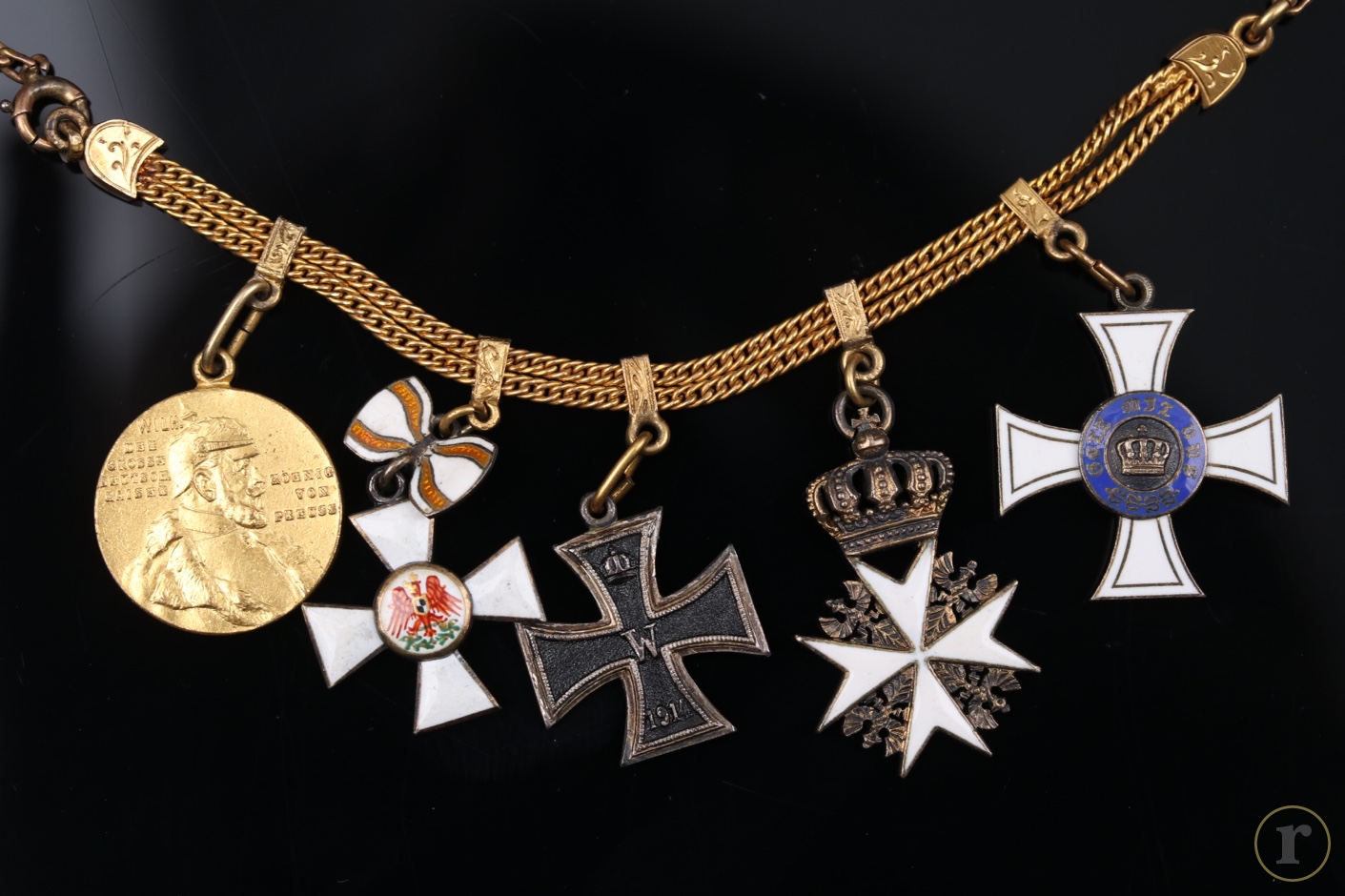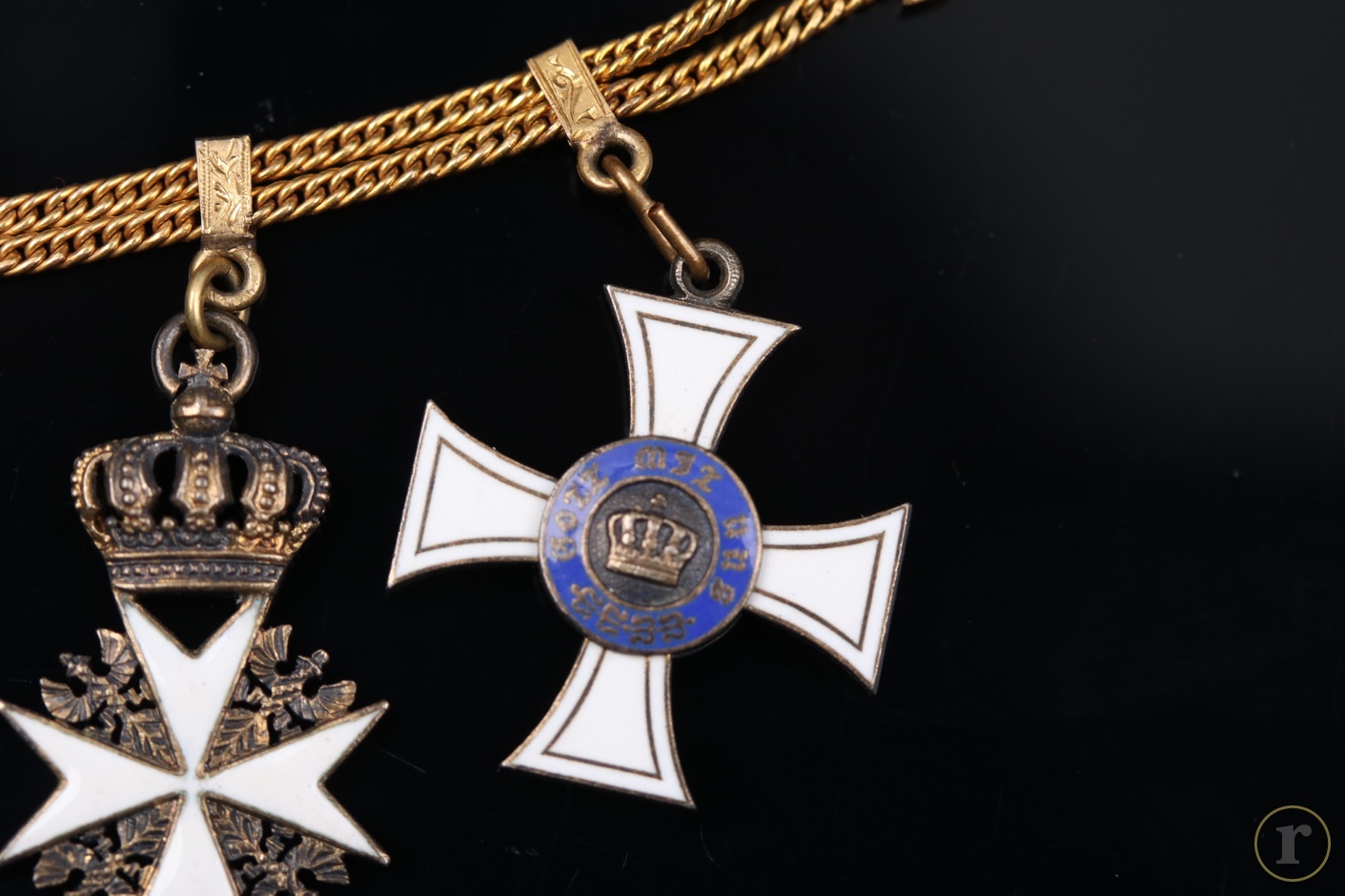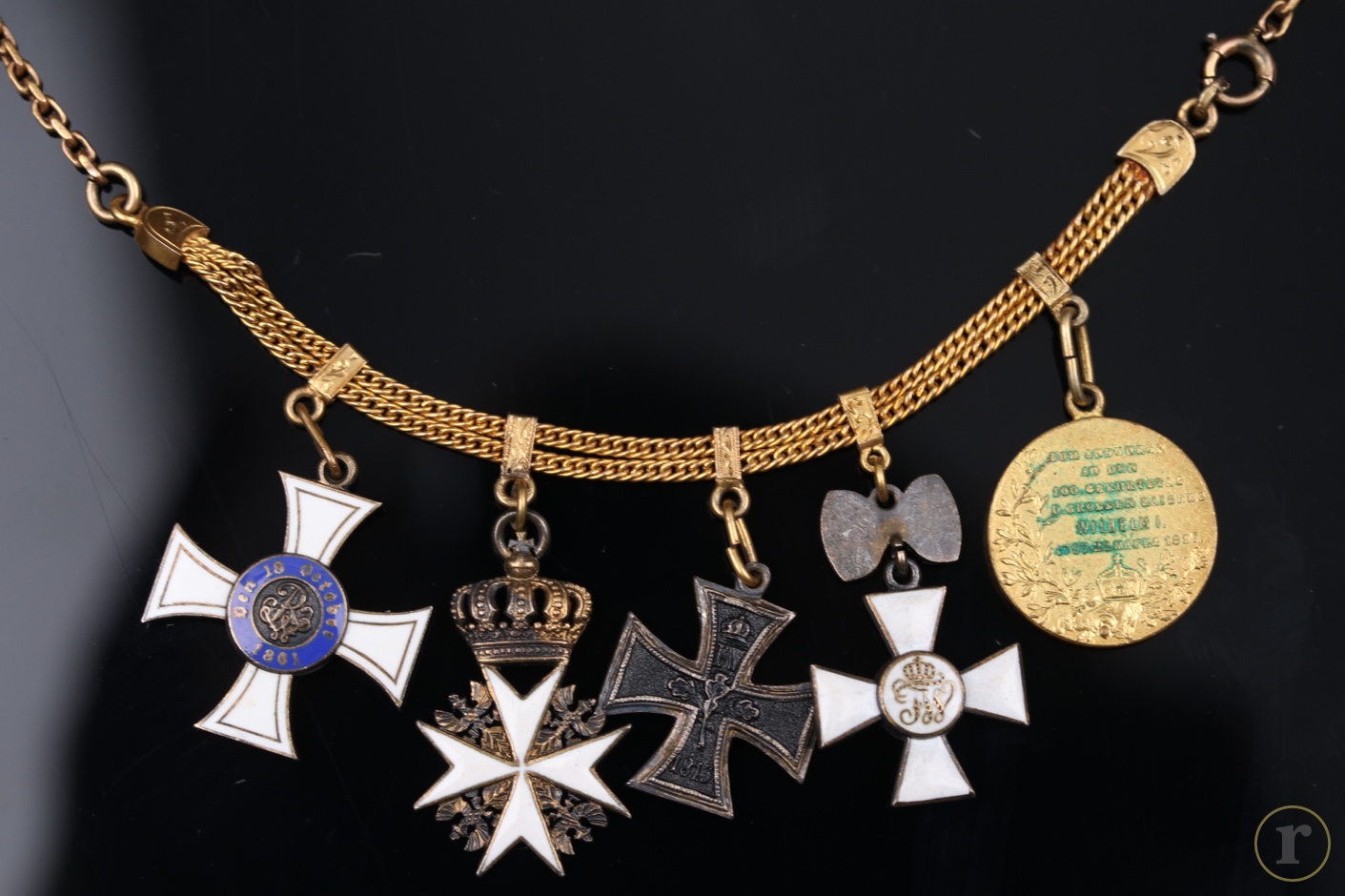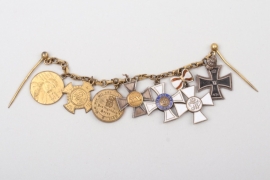Cross 3rd Class with Bow
Buy treasures for a reduced Buyer‘s Premium

Red Eagle Order 3rd Class with Bow on Miniature Chain
on a reduced buyer's premium
We are buying single items and entire collections! Call +49 8541 9053699
-
MEDALNET APPRAISAL SERVICES
-
MEDALNET APPRAISAL SERVICES
MEDALNETSERVICES.COMThis item was examined and validated in cooperation with MEDALNET APPRAISAL SERVICES. Our team’s knowledge base received the most competent boost for orders and decorations for imperial orders and decorations with the help of Bernd Kruse and Andreas M. Schulze Ising. Andreas and Bernd are held in high regard with collectors around the world. With more than 50 years of experience in the field of order decorations and medals, they are seen as competent and independent experts.
GUARANTEEAs usual, we offer a full right of return for originality within the withdrawal period for items that are offered in cooperation with MEDALNET APPRAISAL SERVICES.
MEDALNET APPRAISAL SERVICES
-
-
PAYMENT
-
HOW CAN I PAY FOR MY ORDER?
AUCTIONSYou will receive an e-mail confirming your successful bids the day after the auction has ended. In your personal my ratisbon's you will be able to inform us about your most convenient payment method for this order or tell us about an alternative shipping address.
If we don’t hear from you within 24 hours, we will send an invoice choosing the payment and shipping options which we think are the most comfortable ones to you. If you decide to change your shipping or payment method after receiving your invoice, just drop us a line or visit my ratisbon's/ORDERS for any more details.
SHOP ORDERSChoose your payment method when ordering and submit your order. Once your order has been received we will send an invoice including your shipping costs and your payment instructions.
After receiving the invoice, the order must be paid within 7 days.
Please contact us to discuss layaway options.To learn more about paying at ratisbon's, please see your FAQ pages.
WE ACCEPT FOLLOWING PAYMENT METHODS
-
-
Versand
-
HOW DO YOU SHIP MY NEW TREASURES?
PACKING & TRACKINGWe usually send out orders within 1-3 working days after your payment has been received. In most cases, we are faster than this! We will inform you when your goods are being dispatched and provide a tracking number, In addition, you can always check your order status at my ratisbon's/ORDERS. Delivery times will vary depending upon the delivery destination and type of shipping service you have chosen.
SHIPPING TO ALTERNATIVE ADDRESSIf you prefer to have your order shipped to your work address or a friend during your absence, we will happy to arrange this for you. Send us an email letting us know about your new shipping address and we will be happy to send an updated invoice to you.
OUR LOGISTIC PARTNERS ARE AS FOLLOWS
-
-
OUR GUARANTEE
-
 OUR GUARANTEE!
OUR GUARANTEE!We only offer collectables which to the best of our specialists knowledge are authentic. About 15% of all consignments are returned to the consignor after extensive research due to authenticity issues.
Unlike traditional auction houses we do offer a full right of return. If you are not satisfied with what you won or bought, you may return it within 14 days. Please inform us and we will instruct you on how to return the goods. For more information, please visit FAQ pages.
Important note: Cancelling bids after an auction may disappoint the consignor, who like you is a collector. This situation is easy to avoid. We encourage you not to bid on any collectable if you are unsure if it fits into your collection. Ask us to cancel your bid 24 hours prior to the end of an auction to avoid this situation.
-
COUNTRY Imperial Germany
DIMENSIONS 18
WEIGHT 16.6 g
EAN 2000000593548
PERIOD until 1918
COUNTRY Imperial Germany
MATERIAL silver
DIMENSIONS 18
MAKER
WEIGHT 16.6 g
COUNTRY Imperial Germany
LOT K-7553
DIMENSIONS 18
EAN 2000000593548
MAKER
WEIGHT 16.6 g
Red Eagle Order 3rd Class with Bow on Miniature Chain
Description
Miniature Chain of a St. John knight with Prussian Crown Order 2nd Class, Prussian St. John Knight of Justice, Iron Cross 2nd Class 1914, Red Eagle Order Cross 3rd Class with Bow and Centennial Medal.
Beautiful ensemble on chain attached to a necklace for wear by a woman. Maybe in memory of her husband.
Miniatures in fantastic workmanship in gilt silver and enamel. Detailed Red Eagle Painting in its center medaillion.
Condition
1
Friedrich Wilhelm II., King of Prussia, resurrected the Brandenburg Red Eagle Order on June 12, 1792, as a single class order. King Friedrich Wilhelm III added a 2nd and 3rd class to the order on January 18, 1810, creating today's well-known design. At first, the decorations of the 2nd and 3rd class were identical in size.
The cross of the order was designed as a Latin cross in white enamel, showing the red Brandenburg eagle on a white enameled center medallion. The reverse medallion showed the cypher “FW” for its founder Friedrich Wilhelm. The star was eight pointed and has a white enameled center showing again the red Brandenburg eagle surrounded by the golden orders motto in between silver pearled rings: “Sincere et constanter” (aufrichtig und beständig), terminated on the bottom by a laurel wreath.
All those who had been awarded the 3rd class before being promoted to the 2nd class of the order received a golden oak leaf attached to the ring of the higher class. This change to the statutes was made on January 18, 1811. Only those knights of the order that received the 3rd and later 2nd class could wear the oak leaf on the 1st class decoration and star.
Inspired by the different sizes of the Russian Order of St. George, the king verbally changed the size of the 3rd class decoration to a smaller version on December 21, 1817.
The structure of the order was amended on January 18, 1832. First, the General Service Cross was promoted into the order, redesigned, and re-named the 4th class Red Eagle Order. Also, the 2nd class could now be awarded with (or without) a newly created star. The rules for the oak leaf applied for the star as well. Finally, the eagle design was changed, by personal intervention of King Friedrich Wilhelm III, to a more pleasing look, which now incorporated the Hohenzollern Coat of Arms.
Analog to the oak leaf, a bow was created on January 22, 1832, to be worn above the ring of the 3rd class of the order by those who had previously been awarded the 4th class.
With King Friedrich Wilhelm III.’s order of January 17, 1846, the 4th class was redesigned and featured from then on an enameled center medallion just like on all higher grades. In addition, the design of the eagle was again updated for all classes.
The swords were created on September 16, 1848, for merit during war and affixed through the medallion. If a recipient was promoted to a higher grade and had been awarded the lower grade with swords, the swords of the lower grade were mounted on the ring of the cross of the higher grade, and on the star (if awarded) above the center medallion.
On February 11, 1850, Crowns and Scepters were awarded to a few recipients who facilitated the suppression of the 1848/49 revolution. Because the revolution was viewed as a heinous, treasonous act, the recipients did not wish to be promoted to a higher grade of the Red Eagle Order for their part in suppressing it. Honoring their wishes, the king awarded the devices as additions to their existing orders.
To honor non-Christian recipients, who were thought to be potentially sensitive to the orders cruciform design, a special star and round design of the Red Eagle Order was created on February 26, 1851.
On December 19, 1851, the king created a special jubilee number to be worn on either the oak leaf or the bow, or as a plaque on the decoration itself, for those celebrating a minimum of 50 year service. For 60 years of service the number “60” was awarded with the Red Eagle Order.
The stars to the 1st and 2nd class were originally embroidered from textile and metal thread. On February 26, 1857, they were ordered made of solid silver and gold. The design differs from the design we know from the last model after July 31, 1854 to approximately the middle of the 1860th.
Numerous complaints from the recipients of the specially designed Red Eagle Order for Non-Christians finally convinced Wilhelm I. to permit recipients to exchange their decorations for those of regular design. On July 5, 1861, Wilhelm I. ordered that, from then on, awards of the Red Eagle Order for Non-Christians were to be made at his personal command only.
As of October 12, 1861, Prussians promoted to a higher grade of the Red Eagle Order who had received swords for bravery on the lower grade, were to wear the oak leaf on the 1st and 2nd class, as well as the bow on the 3rd class, in addition to the swords on ring.
King Wilhelm I. created the Grand Cross of the Red Eagle Order with Star and Collar Chain on Coronation Day, October 18, 1861, in a new and different design to the existing one. The Brandenburg Eagle moved from the center of the order fourfold in between the now Maltese shaped cross arms.
On October 18, 1864, it was ordered that all St. John knights who volunteered to care for the wounded wear a miniature St. John cross on the ring, bow or oak leaf of all Red Eagle Order decorations. This statute was adapted only for the wars in 1864 and 1866.
The manner of wearing the Crown Order and Red Eagle Order simultaneously in the 1st class was redefined on January 18, 1865. Wearing both at the same time was no longer permitted. Instead, recipients were to wear only the order they received first, and an enameled ribbon of the order not worn was affixed around the cross center and the stars medallion. The ribbon of the Red Eagle Order was worn on the Crown Order if the recipient had received the Red Eagle Order first, and vice versa. This custom was abandoned May 4, 1888. From then on, the star of the initially awarded order was not worn anymore but the cross worn on the neck on a narrower ribbon after the statue.
Various changes and adaptations planned by the 99 day emperor Friedrich III. to streamline the Prussian Order system and especially the Red Eagle Order were reverted by Wilhelm II.
With the 100-year jubilee of the creation of the Red Eagle Order in 1892, the crown to the order was created. Wilhelm II. would award the crown personally on special occasions only. However, the crown did not represent another level within the order.
On January 7, 1914, Wilhelm II added the so-called Kleindekoration, a smaller version of the Grand Cross and 1st Class Set. These were to be worn on the coat, mess coat and hunting dress.
With the First World War degenerating into a long and costly trench warfare, precious raw materials grew scarce. Even the materials used for medals and decorations became subject to strict scrutiny. Following similar proclamations in other German states, Prussia mandated that medals and decorations should be made from replacement materials. The General Orders Commission ordered on October 10, 1916, that gold-based decorations should be crafted only from gilt silver with a silver content of 938/1000. By Prussian law those decorations had to be marked with the content mark 938 and the manufacturers control mark. The Prussian Red Eagle Order has compared to all other Prussian and European Orders the most variations within its structure.
















